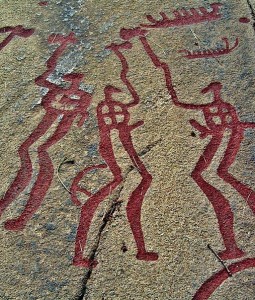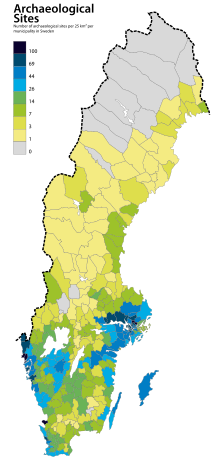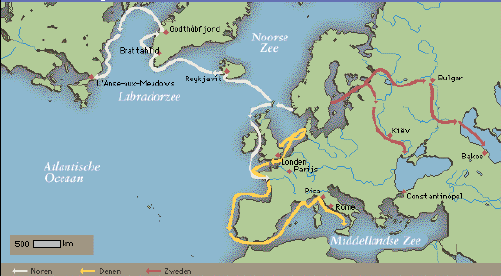 This page is provided as an historical addition to the “Filangeri Family Ties: The Papacy, Dukes of Normandy and the British Monarchy” page. The Filangeri family has been traced back to Rollo, the Viking conqueror, in the 8th century.
This page is provided as an historical addition to the “Filangeri Family Ties: The Papacy, Dukes of Normandy and the British Monarchy” page. The Filangeri family has been traced back to Rollo, the Viking conqueror, in the 8th century.
Prior to Rollo, there is not much genealogically available. There is, however, much history of the Scandinavian people going all the way back to the Stone Age.
Here is a brief overview from the prehistoric age up to the conquering and settlement of Sicily, where the Filangeri family ties come into the picture.
Pre-historic age
Scandinavian prehistory began when the Scandinavian peninsula, formerly entirely covered by thick ice, became free of ice at the end of the last ice age, around 11,000 BC. At that time, a hunter gatherer people, the Ahrensburg culture, lived and hunted near the edge of the ice. It took until the 7th millennium BC for forest, wildlife and Mesolithic hunter-gatherers to fully colonise the newly available land. In southern Scandinavia, a Maglemosian culture (ca 7500 BC–6000 BC) developed.
The Maglemosian people lived in forest and wetland environments using fishing and hunting tools made from wood, bone and flint microliths. A characteristic of the culture are the sharply-edged microliths of flintstone which were used for spear heads and arrowheads. Microliths finds are more sparse from ca 6000 BC and the period is said to transit into the Kongemose culture (ca 6000 BC–ca 5200 BC). The finds from this period are characterised by long flintstone flakes which were used for making the characteristic rhombic arrowheads, scrapers, drills, awls and toothed blades.
The Ertebølle culture (ca 5300 BC–3950 BC) is the name of a hunter-gatherer and fisher culture dating to the end of the Mesolithic period. It was followed by the Funnelbeaker culture (4000–2700 BC) a culture that originated in southern parts of Europe and slowly advanced up through today’s Uppland, Sweden. Tribes along the coasts of Svealand, Götaland, Åland, north-eastern Denmark and southern Norway learnt new technologies that became the Pitted Ware culture (3200 BC – 2300 BC).
Around 2800 BC, metal was introduced in Scandinavia in the Corded Ware culture. In much of Scandinavia, a Battle Axe culture became prominent, known from some 3,000 graves. The period 2500 BC – 500 BC also left many visible remains to modern times, most notably the many thousands rock carvings (petroglyphs) in western Sweden at Tanumshede and in Norway at Alta.
A more advanced culture came with the Nordic Bronze Age (ca 1800 BC – 500 BC). It was followed by the Pre-Roman Iron Age (5th/4th century BC – 1st century BC) and the Roman Iron Age (ca 1 – 400 AD).
Ice age
The pre-history of Sweden begins at the end of the Pleistocene epoch at the beginning of Holocene epoch, following the last ice age, the Weichselian glaciation. At the end of the ice age, large parts of south and middle Sweden was covered by water.
Parts of Denmark, Scania and the Norwegian coast line were free from ice around 13000 BC, and around 10000 BC the rim of ice was around Dalsland, Västergötland and Östergötland. It wasn’t until 7000 BC that all of Svealand and the modern coastal regions of North-eastern Sweden were free of ice, although the land was by then deeply pressed underwater.
In Scandinavia, the time following the ice age begins at circa 9500 BC and is called at first the Yoldia Stage, after the Yoldia Sea, then the Ancylus Stage, after the Ancylus Lake in turn named after Ancylus fluviatilis, a small fresh-water gastropod from this time. By this time, Denmark and Sweden were joined and the “Baltic Sea” of the age was a fresh water lake called the Ancylus Lake. The Ancylus age is followed by formation of the Littorina Sea and the Litorina Stage (named after the Littorina littorea mollusc) at around 6200 BC.
With the first human colonization of this new land (the territory of modern Sweden was partly under water though, and with radically different coastlines) during the Ancylus and Litorina ages begins the Nordic Stone Age. In recent years there have been archaeological finds in caves which strongly suggest human inhabitation of Scandinavia before the Weichsel glaciation, at least 50,000 years ago, presumably by Neanderthals.
Stone Age
Upper Paleolithic
As the ice receded, reindeer grazed on the flat lands of Denmark and southernmost Sweden. This was the land of the Ahrensburg culture, tribes who hunted over vast territories and lived in lavvus on the tundra. There was little forest in this region except for arctic white birch and rowan, but the taiga slowly appeared.
Mesolithic
In the 7th millennium BC, when the reindeer and their hunters had moved for northern Scandinavia, forests had been established in the land. The Maglemosian culture lived in Denmark and southern Sweden. To the north, in Norway and most of southern Sweden, lived the Fosna-Hensbacka culture, who lived mostly along the edge of the forest. The northern hunter/gatherers followed the herds and the salmon runs, moving south during the winters, moving north again during the summers. These early peoples followed cultural traditions similar to those practised throughout other regions in the far north — areas including modern Finland, Russia, and across the Bering Strait into the northernmost strip of North America.
During the 6th millennium BC, southern Scandinavia was covered in temperate broadleaf and mixed forests. Fauna included aurochs, wisent, moose and red deer. The Kongemose culture was dominant in this time period. They hunted seals and fished in the rich waters. North of the Kongemose people lived other hunter-gatherers in most of southern Norway and Sweden called the Nøstvet and Lihult cultures, descendants of the Fosna and Hensbacka cultures. Near the end of the 6th millennium BC, the Kongemose culture was replaced by the Ertebølle culture in the south.
Neolithic
During the 5th millennium BC, the Ertebølle people learned pottery from neighbouring tribes in the south, who had begun to cultivate the land and keep animals. They too started to cultivate the land, and by 3000 BC they became part of the megalithic Funnelbeaker culture. During the 4th millennium BC, these Funnelbeaker tribes expanded into Sweden up to Uppland. The Nøstvet and Lihult tribes learnt new technology from the advancing farmers (but not agriculture) and became the Pitted Ware cultures towards the end of the 4th millennium BC. These Pitted Ware tribes halted the advance of the farmers and pushed them south into southwestern Sweden, but some say that the farmers were not killed or chased away, but that they voluntarily joined the Pitted Ware culture and became part of them. At least one settlement appears to be mixed, the Alvastra pile-dwelling.
It is not known what language these early Scandinavians spoke, but towards the end of the 3rd millennium BC, they were overrun by new tribes who many scholars think spoke Proto-Indo-European, the Battle-Axe culture. This new people advanced up to Uppland and the Oslofjord, and they probably provided the language that was the ancestor of the modern Scandinavian languages. They were cattle herders, and with them most of southern Scandinavia entered the Neolithic.
Nordic Bronze Age
Petroglyphs from Scandinavia (Häljesta, Västmanland in Sweden). Composite image. Nordic Bronze Age. The glyphs are painted to make them more visible. It is unknown whether they were painted originally.
Even though Scandinavians joined the European Bronze Age cultures fairly late through trade, Scandinavian sites present rich and well-preserved objects made of wool, wood and imported Central European bronze and gold. During this period Scandinavia gave rise to the first known advanced civilization in this area following the Nordic Stone Age. The Scandinavians adopted many central European and Mediterranean symbols at the same time that they created new styles and objects. Mycenaean Greece, the Villanovan Culture, Phoenicia and Ancient Egypt have all been identified as possible sources of influence in Scandinavian artwork from this period. The foreign influence is believed to be attributed to amber trade, and amber found in Mycenaean graves from this period originates from the Baltic Sea. Several petroglyphs depict ships, and the large stone formations known as stone ships indicate that shipping played an important role in the culture. Several petroglyphs depict ships which could possibly be Mediterranean.
From this period there are many mounds and fields of petroglyphs, but their signification is long since lost. There are also numerous artifacts of bronze and gold. The rather crude appearance of the petroglyphs compared to the bronze works have given rise to the theory that they were produced by different cultures or different social groups. No written language existed in the Nordic countries during the Bronze Age.
The Nordic Bronze Age was characterized by a warm climate (which is compared to that of the Mediterranean), which permitted a relatively dense population, but it ended with a climate change consisting of deteriorating, wetter and colder climate (sometimes believed to have given rise to the legend of the Fimbulwinter) and it seems very likely that the climate pushed the Germanic tribes southwards into continental Europe. During this time there was Scandinavian influence in Eastern Europe. A thousand years later, the numerous East Germanic tribes that claimed Scandinavian origins (Burgundians, Goths and Heruls), as did the Lombards, rendered Scandinavia (Scandza) the name “womb of nations” in Jordanes’ Getica.
Pre-Roman Iron Age
The Nordic Bronze Age ended with a deteriorating, colder and wetter climate. This period is known for being poor in archaeological finds. This is also the period when the Germanic tribes became known to the Mediterranean world and the Romans.
Initially iron was valuable and was used for decoration. The oldest objects were needles, but swords and sickles are found as well. Bronze continued to be used during the whole period but was mostly used for decoration. The traditions were a continuity from the Nordic Bronze Age, but there were strong influences from the Hallstatt culture in Central Europe. They continued with the Urnfield culture tradition of burning corpses and placing the remains in urns. During the last centuries, influences from the Central European La Tène culture spread to Scandinavia from northwestern Germany, and there are finds from this period from all the provinces of southern Scandinavia. From this time archaeologists have found swords, shieldbosses, spearheads, scissors, sickles, pincers, knives, needles, buckles, kettles, etc. Bronze continued to be used for torques and kettles, the style of which were a continuity from the Bronze Age. One of the most prominent finds is the Dejbjerg wagon from Jutland, a four-wheeled wagon of wood with bronze parts.
Roman Iron Age
While many Germanic tribes sustained continued contact with the culture and military presence of the Roman Empire, much of Scandinavia existed on the most extreme periphery of the Latin world. With the exception of the passing references to the Swedes (Suiones) and the Geats (Gautoi), much of Scandinavia remained unrecorded by Roman authors.
In Scandinavia, there was a great import of goods, such as coins (more than 7 000), vessels, bronze images, glass beakers, enameled buckles, weapons, etc. Moreover, the style of metal objects and clay vessels was markedly Roman. For the first time appear objects such as shears and pawns.
There are also many bog bodies from this time in Denmark, Schleswig and southern Sweden. Together with the bodies, there are weapons, household wares and clothes of wool. Great ships made for rowing have been found from the 4th century in Nydam mosse in Schleswig. Many were buried without burning, but the burning tradition later regained its popularity.
Through the 5th century and 6th century, gold and silver became more common. Much of this can be attributed to the ransacking of the Roman Empire by Germanic tribes, from which many Scandinavians returned with gold and silver.
Germanic Iron Age
The period succeeding the fall of the Roman Empire is known as the Germanic Iron Age, and it is divided into the early Germanic Iron and the late Germanic Iron Age, which in Sweden is known as the Vendel Age, with rich burials in the basin of Lake Mälaren. The early Germanic Iron Age is the period when the Danes appear in history, and according to Jordanes, they were an offshoot of the Swedes (suehans, suetidi) who had replaced the Heruls.
During the fall of the Roman empire, there was an abundance of gold that flowed into Scandinavia, and there are excellent works in gold from this period. Gold was used to make scabbard mountings and bracteates; notable examples are the Golden horns of Gallehus.
After the Roman Empire had disappeared, gold became scarce and Scandinavians began to make objects of gilded bronze, with decorations of interlacing animals in Scandinavian style. The early Germanic Iron Age decorations show animals that are rather faithful anatomically, but in the late Germanic Iron Age they evolve into intricate shapes with interlacing and interwoven limbs that are well-known from the Viking Age.
Kvenland
Kvenland, known as Cwenland, Kænland and similar terms in medieval sources, is an ancient name for an area in Scandinavia and Fennoscandia. A contemporary reference to Kvenland is provided in an Old English account written in the 9th century. It utilized the information provided by the Norwegian adventurer and traveler named Ohthere. Kvenland, in that or nearly that spelling, is also known from Nordic sources, primarily Icelandic, but also one which was possibly written in the modern-day area of Norway. All the remaining Nordic sources date to the 12th and 13th centuries, but some of them – in part – are believed to be rewrites of older texts. Other references and possible references to Kvenland by other names or spellings are discussed in the main article of Kvenland.
Viking Age
During the Viking Age, the Vikings (Scandinavian warriors and traders) raided, colonized and explored large parts of Europe, the Middle East, northern Africa, and North America, more specifically the modern area identified as Newfoundland.
The Split
The Vikings homeland was Scandinavian, which consisted of three major countries Denmark, Norway, and Sweden. Each country extended their power into Europe, and effected three different areas giving them the largest trade network of the time.
The Swedish Vikings began to explore, trade, and raid Eastern Europe and Russia. They had economic influence in the Black Sea, the Caspian, and Eastern Mediterranean. In Russia the Swedish Vikings became so powerful they founded a dynasty that ruled Kiev.
Then there were the Vikings who explored the North Atlantic and expanded westward to Iceland and Greenland. These were Vikings from Norway.
The Danish Vikings extended to the Eastern coast of England, and the western coast of Europe. They made raids that extended to Spain, the Mediterranean, and Northern Africa. In England they formed the towns of Dublin and York. These were the Vikings from which conquered Sicily, and from which the Filangeri Dynasty comes from.
The beginning of the Viking Age is commonly given as 793, when Vikings pillaged the important British island monastery of Lindisfarne, and its end is marked by the unsuccessful invasion of England attempted by Harald Hårdråde in 1066 and the Norman conquest.
Age of settlement
Scandinavian settlements and voyages
Below is a map of where each of the three Viking branches spanned. The Yellow line represents the Danish branch, which represents where the Filangeri Dynasty originated:
The age of settlement began around 800 AD. The Vikings invaded and eventually settled in Scotland, England, Greenland, the Faroe Islands, Iceland, Ireland, Livonia, Normandy, the Shetland Islands, Sicily, Rus’ and Vinland, on what is now known as the Island of Newfoundland.




362 thoughts on “History of Scandinavia”
You must log in to post a comment.